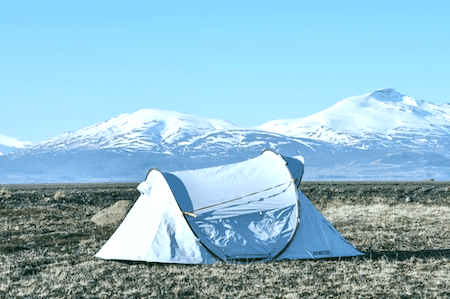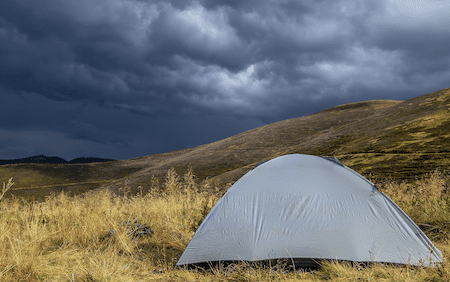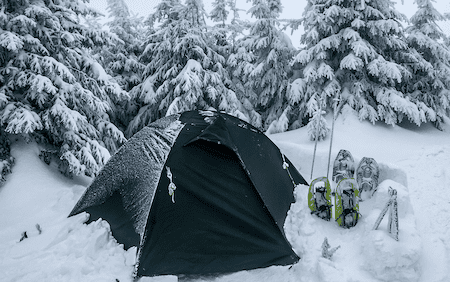All of us campers have experienced wet tents at some point. Maybe your tent leaked. Or perhaps you brought it in, thinking the weather would be sunny, only to find out later that the day turned out to be overcast and rainy.
Obviously, the issue isn’t the tent getting wet but rather keeping it wet.
Putting away a tent wet can lead to many complexities, like mold and mildew growth and accelerated degradation of the tent’s fabric.
Accordingly, there’s probably no more immediate and more significant concern than thoroughly drying your tent before and after each use.
With that said, let’s learn how to dry a tent quickly across different settings and weather conditions, so you can get back to enjoying your camping trip without worries.
Why Is Drying Your Tent A Big Deal?
First of all, you want your tent dry before packing for a camping trip so it won’t be damp when it’s time to pitch it.
After all, a wet tent will probably cause you to get other gear damp, which can ruin all the fun of your camping. It applies even when you put the tent inside a tent bag since most aren’t waterproof.
But why is it important to dry the tent promptly after returning from a trip?
That’s because you don’t want any mold or mildew on your tent’s surface the next time you set it up, something that can happen when you let the moisture sit on the fabric.
These growths can not only cause leaks and damage your tent, but they can also pose a whole host of health risks.
And if you’re using accessories, a tent carpet, for instance, things may get complicated even further.
Drying A Tent Outdoors
Undoubtedly, the best way to dry a tent is to do so outside, whether you’re packing your gear or coming home from a trip, as the sun and air will do all the hard work for you.
In dry weather, you can hang up the rainfly as far apart as you can or lay it out on a sun-drenched patch of grass, a rocky outcrop, or even a camping table. Be sure to flip the rainfly every once in a while to allow it to dry quickly on both sides.
If your tent doesn’t have a rainfly, don’t worry, you can make a rainfly for your tent.
It’s best to take out all of your backpacking equipment and open every door, window, and vent to let in as much air as possible.
Having enough airflow will help dry your tent much faster. If your clothes are wet, dry them as well. It’s a lot easier to pack dry clothes and tents than wet ones!
When your tent is freestanding, place it in a sunny place to hasten the process. You can also turn some freestanding tents on their sides to allow their bottoms to dry.
Just make sure the tent poles do not bend or break. Learn the difference between aluminum and fiberglass tent poles before you choose one.
And if you notice water puddles within the tent, grab a microfiber towel to wipe them away.
Sunny Days Are Ideal For Airing Out The Tent
The simplest method for airing a tent is to do it on a sunny day!
Simply set up your tent in a sun-drenched spot once you are home or at the campsite, and leave all the windows, doors, and vents open to let the sun do all the work for you.
How To Dry A Tent In The Rain
One can’t really dry a tent when it’s raining, can they? However, it’s quite possible to dry it within a wet ambiance soon after rain.
To do so, you’ll just have to wait until the rain stops or move it into a shelter. It’s also a good idea to take everything out and put it either in your car or the shelter. After that, you can take the tent apart, put it in the shade, and hang it up to dry.
The drying will be much easier if you can set up a clothesline. And if you’ve got a freestanding tent, you can move it under the shelter while still erected and leave it to dry there.
Now, what if there is no shelter nearby to move your tent too? Don’t worry; you can handle it too.
Just find a large, standing upright rock or a tall, wall-like structure and splay out the wet tent over it as much as you can spread it out. The fewer overlaps, the better.
Once again, you must ensure that any standing water on your tent is wiped up and all the openings are uncovered, allowing air to circulate to have the water evaporate.
In addition, putting a tarp over your tent and against the rain’s direction is a worthwhile idea to keep your tent dry even when it rains!
Yes, you could zip your tent up to keep the water out, but that can reduce ventilation and produce a lot of humidity inside the tent.
How To Dry A Tent In Winter
During the winter, tents can be challenging to dry, but once again, the aid of a sunny spot and adequate airflow will generally do the trick for you. You can expect to face minimal hassle so long as your tent isn’t soaking wet with liquid water.
You can easily brush off snow and ice from the tent before packing up by wiping out the inside with a microfiber towel. After that, you can let it dry out in the sun and wind using the general air-drying method.
However, drying the tent this way will take much longer than in the summertime. In that case, a portable electric lamp or candle lantern inside the tent would be very useful in speeding up the process.
Besides substantially reducing moisture and humidity, it will also provide your body with some much-needed warmth.
How To Dry A Tent At Home
Drying a tent at home may not be the best option right away, but it’s the only option when you can’t set the tent out to dry outdoors.
For instance, when it’s raining or snowing, or you live in a small apartment and simply have no outdoor space at all.
When you have enough space in your house, you can dry a tent indoors without a hitch if it’s a freestanding tent.
You can simply set up the tent anywhere in your home that is large enough, blot up any moisture with a microfiber cloth, open up all vents, and switch on your ceiling fan.
Yet, drying out a large, non-freestanding shouldn’t be much hassle either, even when you’re living in a small apartment if you think creatively.
Here are some ideas.
#1. Working In A Small Space
You cannot dry a tent overnight by putting it up and forgetting about it when the space is small. If it’s 3-4 days working around the tent, you may even go crazy.
So, consider keeping the tent in one corner and rearranging your furniture to make more room.
It might be a good idea to pull your couch closer to the living room and hang your tent behind it on a clothesline.
You can do the same thing in front of an infrequently-used patio door or behind your kitchen counter. Just remember to switch sides of the tent to dry on both sides.
#2. Use An Improvised Clothesline To Hang The Tent
The term ‘Improvised clothesline’ can take up numerous forms here. Such as:
- Some para-cord strung through your garage or living room
- Hooks in the ceiling or walls to anchor the tent’s edges
- Chairs or stands, or stools to raise the tent off the ground
- Your apartment’s balcony rail (it’s best to wipe it off first; those tend to get messy)
- A tree branch if one is nearby (avoid rubbing the tent fabric, particularly the mesh, against the tree’s bark).
- An actual clothesline that is durable against your tent’s weight (then it’s no longer an improvised line).
#3. Use An Air Blower Or A Box Fan
You can use an air blower to dry out your tent when you don’t have much space in your apartment to spread it out.
Set it to a moderate speed (not high-speed as it may weaken the seams), and it should be able to dry your tent even with lots of wrinkles and overlaps.
Alternatively, you can use a box fan to double up the airflow power alongside your ceiling fan to dry your tent.
#4. Dry It Over Your Shower Curtain Rod
If you have no other option, you can hang your tent over your shower rod. The problem with this method is that you’ll have to move the tent each time you try to get ready.
Also, the typical apartment bathroom lacks space and ventilation, so it might only work for a small tent. You may need to overlap when you have a larger one and slowly work across its whole surface.
If you choose this route anyway, be sure to take down the tent before you shower. Wipe down through the entire tent surface with a damp rag and turn the exhaust fan on before hanging the tent up again. Be prepared for the tent to remain moist for about two weeks.
How Not To Dry Your Tent
Understanding how to dry a tent properly is as critical as knowing how not to do it since an improper approach can ruin the tent for good.
Here’s what you’ll want to avoid.
#1. Drying A Tent In Its Carry Bag
It may be tempting to place the tent in its carrying bag and let it dry by itself, but it’s never a wise decision.
Tent bags are not supposed to be dried in, so this method would be among the worst. Doing so will cause the tent to retain moisture, promoting the growth of mold and mildew. Only use the carry bag when the tent is dry.
#2. Drying the Tent In A Clothes Dryer
Another way to cause unnecessary damage to your tent is by drying it in a clothes dryer. Clothes dryers use heat for the drying process.
This heat can badly mess up nylon tents and warp and shrink the fabric and canvas tents. The tumbling also weakens tent fabrics, causes tears, and reduces their lifespan.
For this reason, you should never use a clothes dryer, not even briefly.
#3. Drying A Tent With A Hair Dryer
Hairdryers should not be used to dry tents, even if they are relatively small. When using a hairdryer to heat the tent, the hot air shrinks cotton, melts synthetic fabrics, and warps them.
While a dryer set to cold might work, it is still far less effective than a large fan.
Frequently Asked Questions
How Long Does It Take A Tent To Dry?
Depending on the amount of moisture, airflow, tent material, and the drying method, it may take up to an hour and a half to dry out completely.
Canvas tents dry the longest, while modern backpacking tents dry the quickest.
How Long Can You Leave A Tent Wet?
In the unlikely event that you need to pack away a wet tent, try not to keep it that way more than a day.
Usually, mold starts growing on tent fabric in 24-48 hours.
How To Dry A Canvas Tent?
Canvas tents do not need unique drying methods; you could use simple techniques discussed above.
However, canvas takes noticeably longer than other materials to dry.
Do Waterproofed Tents Need Drying Too?
Yes, they do.
The waterproofing may keep the inside dry, but it’ll still allow mold growth as the water collects.
Thoughts
In the end, there is no real golden ticket to drying a wet tent other than time and patience.
But you can get it done faster if you have the proper knowledge for the job, as we hope you now possess. Also, consider camping somewhere you’ll have the facilities to do the drying job with ease.
Are there any other challenges you encounter while learning how to dry a tent quickly?
If yes, feel free to ask out in the comments below.




